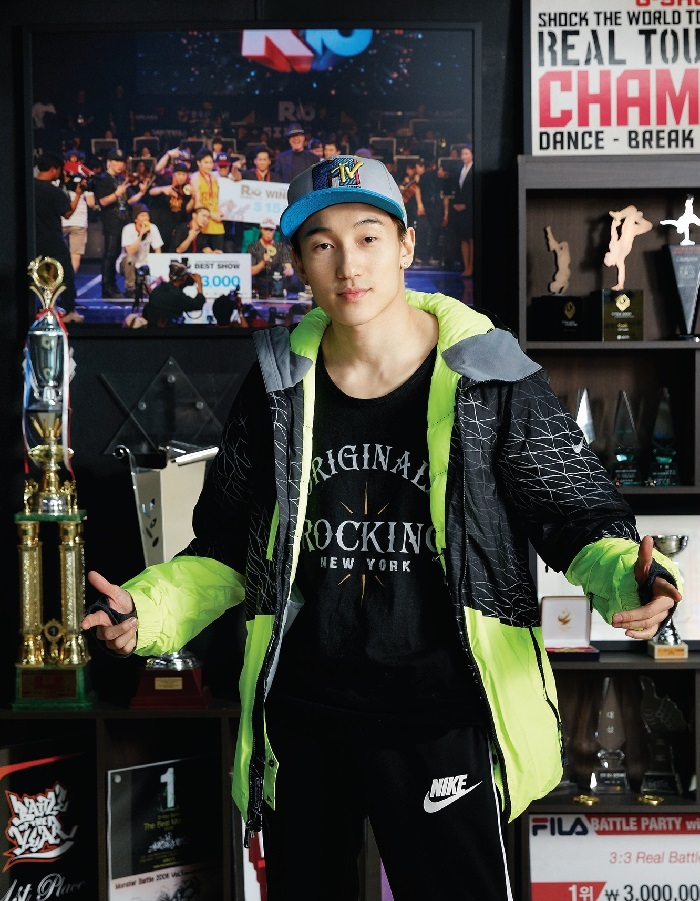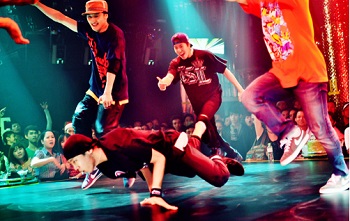View this article in another language
- 한국어
- English
- 日本語
- 中文
- العربية
- Español
- Français
- Deutsch
- Pусский
- Tiếng Việt
- Indonesian
“B-boying,” or break dancing, may have originated in New York City, but in the last decade or so, Korea has established itself as a b-boy powerhouse, steadily raking in awards and taking the top spots at international competitions. The government has caught on, and since 2007 has sponsored R-16 Korea, an international b-boy tournament.

The Extra Mile
B-boy “Skim,” or Kim Heon-jun, leader and founder of Seoul-based b-boy team The Jinjo Crew, credits his and his rival teams’ rise in b-boy prominence to the tireless efforts of individual b-boys. He doesn’t have any secret formula to explain his success in particular, but he does believe that Koreans go that extra mile in terms of dedication.
“I’ve seen many b-boys here sacrifice other things to devote themselves to dance,” says Kim, “but elsewhere, there are many b-boys who treat it more as a hobby.” The Jinjo Crew does practice hard, coming into the studio every day from 1 to 9 PM.
As Kim puts it, they’re not globally acclaimed for nothing. The Jinjo Crew shot to leading status when it won the unique honor of being the only team in the world to take the top spot at all of the world’s five major b-boy championships, achieving “grand slam” status.
Skim founded The Jinjo Crew in 2001 and choreographs with his younger brother, B-boy “Wing.” He cites older b-boys and a popular comic as his main influences, and readily confesses that he got into b-boying for the simple reason that it looked cool.
 Tight-Knit
Tight-Knit
Although every member of The Jinjo Crew can dance for a living, it’s easy to believe that the members are motivated by the grace and power of movement rather than monetary concerns, because it does look cool.
On the wall of the studio hangs the motto, “Let’s rise and burn,” a reference to the name Jinjo, which means “rising fire.” A group of about twenty dancers, scattered into groups, take turns executing complicated tricks, dancing their souls out. Everyone works together. Veteran dancers offer tips to newcomers.
“Unlike say, pro basketball, where you see teams poaching players from other teams, we’re less about scouting for talent and more about taking b-boys who aren’t as good and nurturing them into true talents,” says Skim.
“Ultimately, we select people whom we can connect with. Not in a fake, forced way. I hate trying to force a connection. I prefer someone that just clicks with us.” This emphasis on camaraderie also influences the attitude Skim has toward the success of his crew. He’s proud of the grand slam, of course, but the first thing he brings up is his pride in The Jinjo Crew managing to stay so tight-knit after all these years.
Not Just for the Elite
Skim believes that there’s potential for b-boying to expand as a hobby, rather than just as the profession of a select few.
“A lot of people balk because they’re afraid of injuries, but that only happens when you try something beyond your current ability. B-boying actually works out your body,” he says.
He gestures to a group photo hanging in the sitting room, featuring a gaggle of bronzed and sculpted figures at a beach.
“Notice how everyone has a great body? All of that comes from dancing. B-boying is a form of self-discipline.”
“People play soccer for a hobby, and you can do that with b-boying too, the way you kick around a ball sometimes. Just find a practice space and try it out.
“Most people just use their bodies for a limited number of actions. They walk, sit down, lie down and run,” he says. “But there’s so much more you can do with your body!”
* Article from Korea Magazine (May 2014)

Kim Heon-jun, leader and founder of Seoul-based b-boy team The Jinjo Crew
The Extra Mile
B-boy “Skim,” or Kim Heon-jun, leader and founder of Seoul-based b-boy team The Jinjo Crew, credits his and his rival teams’ rise in b-boy prominence to the tireless efforts of individual b-boys. He doesn’t have any secret formula to explain his success in particular, but he does believe that Koreans go that extra mile in terms of dedication.
“I’ve seen many b-boys here sacrifice other things to devote themselves to dance,” says Kim, “but elsewhere, there are many b-boys who treat it more as a hobby.” The Jinjo Crew does practice hard, coming into the studio every day from 1 to 9 PM.
As Kim puts it, they’re not globally acclaimed for nothing. The Jinjo Crew shot to leading status when it won the unique honor of being the only team in the world to take the top spot at all of the world’s five major b-boy championships, achieving “grand slam” status.
Skim founded The Jinjo Crew in 2001 and choreographs with his younger brother, B-boy “Wing.” He cites older b-boys and a popular comic as his main influences, and readily confesses that he got into b-boying for the simple reason that it looked cool.

The Jinjo Crew performs in Vietnam. (photo courtesy of Jinjo Crew)
Although every member of The Jinjo Crew can dance for a living, it’s easy to believe that the members are motivated by the grace and power of movement rather than monetary concerns, because it does look cool.
On the wall of the studio hangs the motto, “Let’s rise and burn,” a reference to the name Jinjo, which means “rising fire.” A group of about twenty dancers, scattered into groups, take turns executing complicated tricks, dancing their souls out. Everyone works together. Veteran dancers offer tips to newcomers.
“Unlike say, pro basketball, where you see teams poaching players from other teams, we’re less about scouting for talent and more about taking b-boys who aren’t as good and nurturing them into true talents,” says Skim.
“Ultimately, we select people whom we can connect with. Not in a fake, forced way. I hate trying to force a connection. I prefer someone that just clicks with us.” This emphasis on camaraderie also influences the attitude Skim has toward the success of his crew. He’s proud of the grand slam, of course, but the first thing he brings up is his pride in The Jinjo Crew managing to stay so tight-knit after all these years.
Not Just for the Elite
Skim believes that there’s potential for b-boying to expand as a hobby, rather than just as the profession of a select few.
“A lot of people balk because they’re afraid of injuries, but that only happens when you try something beyond your current ability. B-boying actually works out your body,” he says.
He gestures to a group photo hanging in the sitting room, featuring a gaggle of bronzed and sculpted figures at a beach.
“Notice how everyone has a great body? All of that comes from dancing. B-boying is a form of self-discipline.”
“People play soccer for a hobby, and you can do that with b-boying too, the way you kick around a ball sometimes. Just find a practice space and try it out.
“Most people just use their bodies for a limited number of actions. They walk, sit down, lie down and run,” he says. “But there’s so much more you can do with your body!”
* Article from Korea Magazine (May 2014)